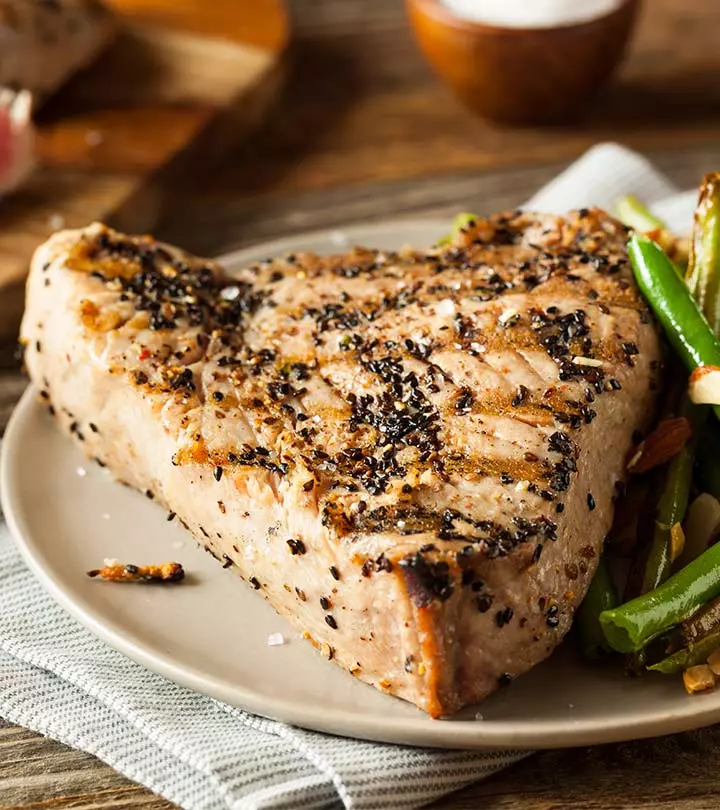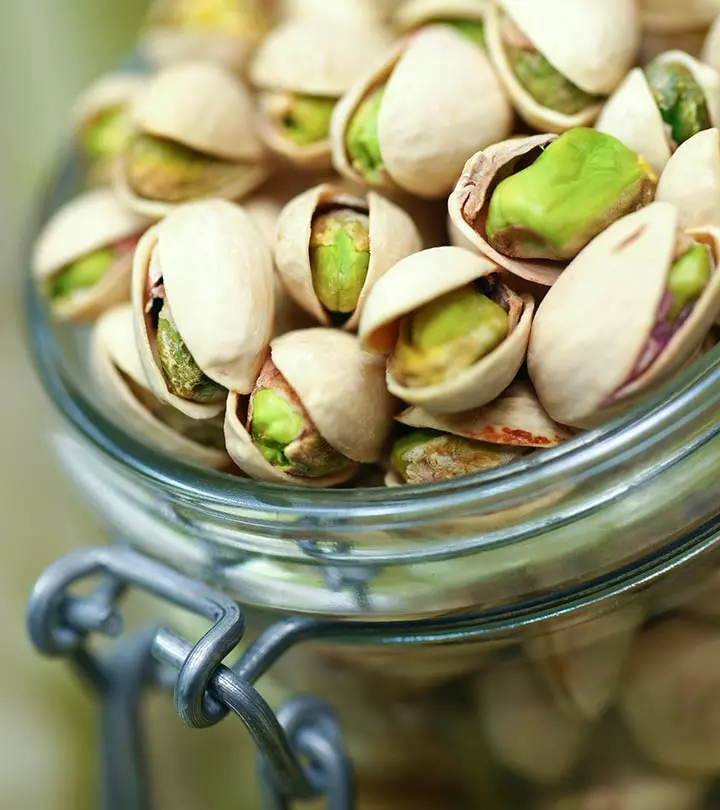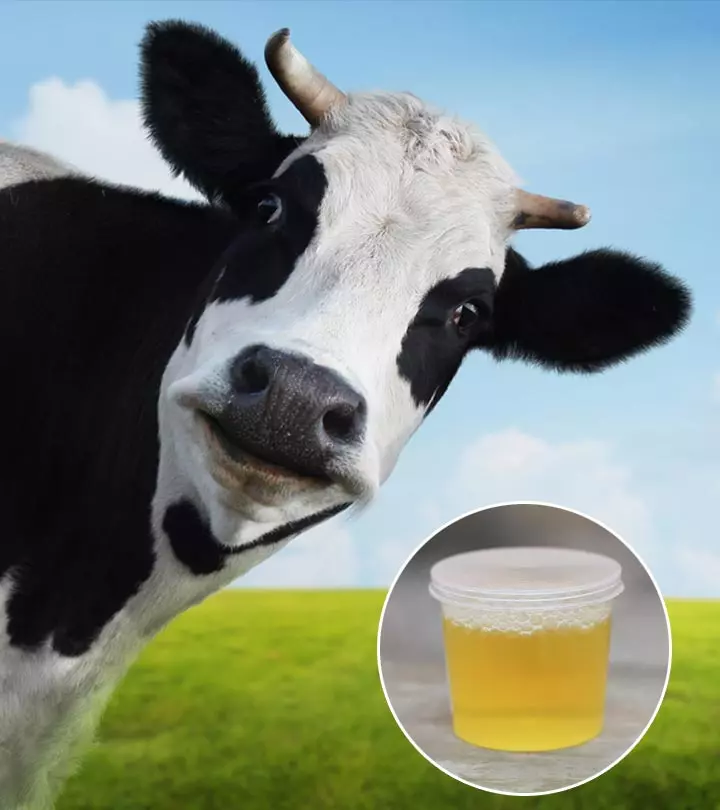Health Benefits Of Tuna For Heart Health, Weight Loss, & More
Indulge in the exquisite flavors of this fish and enjoy holistic health through various mouthwatering recipes.

Image: Shutterstock
Tuna is one of the most consumed fish in the world. The health benefits of tuna can be attributed to its nutrients. This delicious fish boasts many essential vitamins, minerals, and organic compounds. Consuming tuna is said to reduce the risk of heart disease and vision loss, boost immunity, and promote weight loss in obese individuals. It can also be an amazing substitute for processed or red meats besides adding variety to your diet.
This article explores the nutritional profile of tuna fish, its health benefits, potential risks, and healthy and mouth-watering recipes you can try. Keep reading.
In This Article
What Is Tuna Fish?
Tuna is a saltwater fish from the Scombridae family (also known as the mackerel family). It belongs to the Thunnini tribe, which consists of 15 tuna varieties. They regularly migrate between the oceans, and the smaller fish are considered more sustainable. However, some species are endangered.
Tunas are robust and streamlined fish with a cylindrical body and a leg-like tail base. Their bodies taper towards the tail base that is forked or crescent-shaped. They are generally dark silver but often give an iridescent shine (its color looks slightly different from different angles). Fresh tunas have a sweet and salty flavor.
In the next section, we look at the nutrients that make tuna a highly beneficial food.
Key Takeaways
- Rich in essential vitamins and minerals, tuna provides you with several health benefits along with being one of the most commonly consumed fishes around the world.
- It not only helps manage your weight and boost your immunity, but is good for your eye and heart health as well.
- High mercury concentrations in tuna varieties could be a concern if you prefer having it too frequently.
Nutritional Profile Of Tuna Fish
100 grams of tuna fish contain the following nutrients (1):
| Protein | 24.4g |
| Potassium | 441mg |
| Selenium | 90.6 µg |
| Vitamin D | 1.7µg |
| Fat | 0.49 g |
| Carbohydrates | 0 g |
Tuna is loaded with antioxidants and essential nutrients. But how does it help your health? Let us explore the health benefits of tuna fish in the following section.
Health Benefits Of Tuna Fish
1. May Lower The Risk Of Cardiovascular Disease
Consuming fish is associated with a reduced risk of heart disease. Tuna is rich in omega-3 fatty acids that may help widen arteries and delay plaque formation in them (2),(3). Besides, a high intake of these essential fatty acids may also help reduce triglyceride levels and lower blood pressure (4). Tuna is also high in niacin and vitamin B complexes, which may support heart health (5),(6). The potassium-rich tuna also lowers the risk of cardiovascular disease (7).
Anthony Puopolo, a physician, says, “Tuna is high in omega-3 fatty acids, which help lower cholesterol and improve general heart health. It is a great food to introduce into your diet. However, ensure tuna is fully cooked or cured before eating.”
2. May Improve Vision
The omega-3 fatty acids in tuna may help slow down vision loss caused by age-related macular degeneration (AMD). These fatty acids may also reverse the signs of dry eye syndrome (8). Besides, studies suggest that dietary intake of omega-3 fatty acids may be essential for optimal visual development. Their intake was also found to prevent retinal damage in rats. Moreover, administering DHA, an omega-3 fatty acid, before ischemia (reduced blood flow) helped reduce pressure-induced retinal damage in monkeys (9). However, more studies are warranted to understand these benefits of omega-3 fatty acids.
3. May Aid In Weight Loss
Do you know that there is a short-term tuna diet that is popular among people for its alleged weight loss benefits? Protein-rich tuna improves satiety and keeps you fuller for longer durations (10). Eicosapentaenoic acid (EPA), an omega-3 fatty acid, was found to stimulate the production of leptin (an internal hunger hormone), which helps reduce hunger and boost energy levels. However, this phenomenon was only observed in obese individuals. These increased leptin levels may help avoid weight gain after losing weight through calorie restriction (11 ).
4. May Lower Blood Pressure
Tuna contains potassium, which may help lower blood pressure. This mineral counters the negative effects of a high sodium intake (12). A study found that dietary intake of potassium had lowered blood pressure significantly in both hypertensive and non-hypertensive patients. Potassium was also found to reduce the risk of myocardial infarction (https://pubmed.ncbi.nlm.nih.gov/21403995/).
5. May Promote Bone Health
Tuna is an excellent source of vitamin D, which helps our body absorb calcium effectively. Vitamin D deficiency is linked with bone loss, which may eventually lead to osteoporosis (brittle bones), fractures, osteomalacia (softening of bones), and muscle weakness. A study suggests that supplementing vitamin D may decrease bone turnover (resorption) and increase bone mineral density (13). Besides, tuna also contains a significant amount of magnesium and phosphorus that improve bone health (14).
6. May Improve Immunity
Selenium is a powerful antioxidant and a potent immune-boosting nutrient present in tuna. Its deficiency may negatively impact immune cells by impairing several of their functions besides increasing oxidative stress. The selenoproteins in dietary selenium help initiate immunity. Besides, supplementing selenium may also help regulate excess immune responses and manage chronic inflammatory disorders (15).
7. May Promote Skin Health
The selenium and antioxidants in tuna may help reduce free radical damage and delay premature aging signs like wrinkles. Moreover, tuna is a good source of unsaturated fats that make the skin glossy and elastic. Tuna heart extract was also found to boost collagen production and slow down premature aging (16).
8. May Support Mental Health
It has been demonstrated that omega-3 fatty acids, which are abundant in tuna, may help lessen the symptoms of depression and anxiety (17). These essential fats are known to promote brain health by supporting the production of mood-regulating neurotransmitters, which can help improve overall mental well-being.
You may add tuna to your diet to benefit from its potential. But how do you do that? Let us find out in the next section.
How To Add Tuna Fish To Your Diet
The taste of tuna fish makes it ideal for savory dishes like steaks, mayonnaise spreads on crackers or bread, salads, and sandwiches. Some of the other ways to include tuna in your diet include:
- Preparing a Mediterranean salad with tuna
- Baking tuna or topping slices of bread with tuna, cheese, and some olive oil
- Replacing beef with tuna to make burgers
Note:
The FDA recommends eating two to three tuna meals a week to achieve desired results. You can consume at least three meals of light tuna a week. However, white tuna intake should be limited to one or two meals a week (and no other fish that week) as it contains more mercury (17).
 Quick tip
Quick tipWe will now look at some of the popular tuna fish recipes you can try at home. Keep reading.
Popular Recipes Using Tuna Fish
1. Tuna Pasta Salad
What You Need
- Brown rice macaroni pasta – 1 cup (cooked)
- Canned wild-caught tuna – 250g
- ½ red onion (chopped)
- Kalamata olives – ½ cup(pitted)
- Bell peppers – ½ cup (chopped)
- Capers – 2 tablespoons
- Cherry tomatoes – 1 cup (sliced)
- Paleo mayo – ⅓ cup
- Dijon mustard – ⅓ cup
- Salt – ½ teaspoon
- Pepper – ½ teaspoon
- Green onions – ½ cup (chopped – for topping)
- Microgreens – ¼ cup (for topping)
Method
- Mix all the ingredients in a large bowl until they are well combined.
- Refrigerate for 45 minutes.
- Top with chopped green onions and microgreens.
2. Tuna Salad
What You Need
- Canned tuna – 25g (drained and flaked)
- Lettuce – 100g
- Cherry tomatoes – 50g
- Boiled sweet corn kernels – 50g
- Coconut oil – ¼ cup
- Mayonnaise – 5 tablespoons
- Celery – 5 teaspoons (finely chopped)
- Minced onion – 2 tablespoons
- Dijon mustard – 1 tablespoon
- unsweetened dried cranberries – 1 to 2 tablespoons
- Fresh lemon juice – 3 tablespoons
- Salt – ½ teaspoon
- Pepper – ¼ teaspoon
Method
- Add tuna, lettuce, cherry tomatoes, sweet corn kernels, celery, onion, mustard, coconut oil, mayonnaise, and cranberries in a bowl.
- Drizzle with lemon juice, and add salt and pepper to taste.
- Mix gently and refrigerate for at least an hour before serving.
Be careful with what ingredients you add to the tuna salad. A food blogger had a harrowing experience with a new ingredient in their tuna salad, noting, “My tuna salad was almost inedible because this so-called condiment had overwhelmed every other flavor (i).” The unfamiliar sweetener in the pickle relish created an overpowering artificial sweetness, likened to “children’s cough syrup.” Despite rescuing the dish with lemon juice, capers, and pepper, the encounter left a lasting impact. They joked, “I think I may have permanently lost my taste for sweet pickle relish!”
3. Tuna Stuffed Tomatoes
What You Need
- Fresh tomatoes – 4 medium-sized
- Premium white tuna – 2 pouches
- Shredded mozzarella – ½ cup
- Mayonnaise – ¼ cup
- Dijon mustard – 1 tablespoon
- Garlic powder – ½tablespoon
- Onion powder – ½tablespoon
- Green or red onion – 1 diced
- Salt – ½ teaspoon
- Pepper – ¼ teaspoon
- Olive oil – 4 teaspoons
Method
- Preheat the oven to 425oF.
- Scrape the seeds and flesh of the tomatoes gently using a spoon. Place them on a paper towel.
- Combine the tuna with mayonnaise, mustard, and seasonings in a large bowl.
- Scoop the tuna mixture into the tomatoes and place them in a dish lined with a baking sheet.
- Top with shredded cheese, drizzle with olive oil, and roast for 15 minutes.
3. Tuna Casserole
What You Need
- Egg noodles – 2 cups (boiled)
- Condensed cream of mushroom soup – 2 cans
- Milk – 1 cup
- Peas – 1 cup
- Mushrooms – ½ cup (sliced)
- Onions – ½ cup (chopped)
- Cheddar cheese – 1 cup (shredded)
- Tuna – 1 can (drained)
- Breadcrumbs – ½ cup
- Butter – 2 tablespoons (melted)
- Salt – 1 teaspoon
- Pepper – 1 teaspoon
Method
- Combine the condensed cream of mushroom soup and milk in a large bowl.
- Add in the egg noodles, peas, onion, mushrooms, and tuna, and mix well.
- Season with salt and pepper and transfer the mixture to a greased baking dish.
- Combine the breadcrumbs and melted butter in a small bowl and sprinkle it over the top of the casserole along with cheddar cheese.
- Preheat the oven to 375°F and bake the mixture for 25-30 minutes and serve hot.
You need to follow some precautions while consuming tuna fish to avoid adverse effects. Here are a few safety measures to consider.
Safety Precautions To Be Considered Before Eating Tuna Fish
Fish, especially tuna, may contain heavy metals that damage heart health (19), (20). Their toxicity outweighs any potential health benefits of omega-3 fatty acids. Tuna, though very nutritious, is very high in mercury. Hence, consume it in moderation.
Skipjack and light canned tuna, along with other fish low in mercury, can be eaten 2 to 3 times a week. However, albacore, yellowfin, and bigeye tuna should be consumed minimally (18). Canned tuna contains sodium, so people, especially those with diabetes and cardiac problems, should take it in moderation (21). Moreover, pregnant women should consult their doctor before eating tuna due to its mercury content.
Cilantro (also known as coriander) is considered a good chelator for mercury, as are foods containing sulfur such as garlic and broccoli. Add these foods to a meal containing tuna, which may aid in the natural detoxification of the mercury in the fish. However, consult a doctor before consuming tuna and making any changes to your diet.
Despite the wide range of health benefits tuna fish offers, there are certain downsides to consider as well. Keep reading to know what they are.
Side Effects Of Tuna Fish
- Mercury Poisoning
Most fish, including tuna, contain mercury. Over-exposure to mercury may cause memory loss, numbness, shaking, or double vision (22), (23). Hence, caution is advised.
- Bloating
Anecdotal evidence suggests that some people may experience bloating after tuna intake. At times, it may also be coupled with gastrointestinal discomfort and stomach cramps.
- Allergy
Finned fish like tuna may cause reactions such as nausea, vomiting, stomach ache, diarrhea, hives, and itching in the mouth (24). Consult your doctor if you experience any of these symptoms.
- Impact On Environment
Both tuna populations and ocean ecosystems are seriously threatened by overfishing. Unsustainable fishing methods have the potential to destroy ocean habitats, disrupt marine food networks, and reduce tuna stocks as the demand for the fish keeps rising. Selecting tuna from sustainable sources may reduce this negative environmental effect and aid conservation initiatives to save these important marine animals.
 Quick tip
Quick tipThe health benefits of tuna can be attributed to its wonderful nutrients. When included as a part of your regular diet, tuna can reduce the risk of cardiovascular diseases, improve vision, aid in weight loss, and lower blood pressure. As tuna is rich in vitamin D, it improves bone health. In addition, the selenium in tuna improves immunity. Consuming tuna also helps in promoting skin health. You can add this fish to your salads and sandwiches. However, consuming it in excess may negatively impact your heart health. Hence, consume it in moderation to reap its benefits.
Frequently Asked Questions
Is tuna a superfood?
While some experts consider tuna a superfood due to its rich nutrients, protein content, and omega-3 fatty acids, it also carries the risk of mercury contamination. Hence, consume tuna in moderation to reap its health benefits.
Is tuna good for your brain?
Yes. A research study showed that consuming tuna fish more than once a week was associated with slower verbal memory decline (25).
Discover the amazing health benefits of tuna fish. Watch this video and explore the compelling reasons why adding this nutritious powerhouse to your diet might be a game-changer.
Personal Experience: Source
StyleCraze's articles are interwoven with authentic personal narratives that provide depth and resonance to our content. Below are the sources of the personal accounts referenced in this article.
(i) Tuna saladhttps://cooking.livejournal.com/2173007.html
References
Articles on StyleCraze are backed by verified information from peer-reviewed and academic research papers, reputed organizations, research institutions, and medical associations to ensure accuracy and relevance. Read our editorial policy to learn more.
- Fish tuna fresh yellowfin raw
https://fdc.nal.usda.gov/fdc-app.html#/food-details/175159/nutrients - Omega-3 Supplements and Cardiovascular Diseases
https://www.ncbi.nlm.nih.gov/pmc/articles/PMC4153275/ - Impact of omega-3 polyunsaturated fatty acids on vascular function and blood pressure: Relevance for cardiovascular outcomes
https://pubmed.ncbi.nlm.nih.gov/27692558/ - Omega-3 fatty acids and cardiovascular disease
https://pubmed.ncbi.nlm.nih.gov/25720716/ - Vitamin B complex mitigates cardiac dysfunction in high-methionine diet-induced hyperhomocysteinemia
https://pubmed.ncbi.nlm.nih.gov/29509296/ - Niacin Promotes Cardiac Healing after Myocardial Infarction through Activation of the Myeloid Prostaglandin D2 Receptor Subtype 1
https://www.ncbi.nlm.nih.gov/pmc/articles/PMC5325076/ - The importance of potassium in managing hypertension
https://pubmed.ncbi.nlm.nih.gov/21403995/ - Omega 3 fatty acids and the eye
https://pubmed.ncbi.nlm.nih.gov/19227095/ - Effects of Omega-3 Fatty Acids on Eye Health: Summary
https://www.ncbi.nlm.nih.gov/books/NBK11888/ - Optimising foods for satiety
https://www.sciencedirect.com/science/article/pii/S0924224414002386 - Omega-3 fatty acids: a review of the effects on adiponectin and leptin and potential implications for obesity management
https://www.nature.com/articles/ejcn2013197.pdf?origin=ppub - Should we eat more potassium to better control blood pressure in hypertension?
https://pubmed.ncbi.nlm.nih.gov/29301002/ - The effect of vitamin D on bone and osteoporosis
https://pubmed.ncbi.nlm.nih.gov/21872800/ - Monitoring bone changes due to calcium magnesium and phosphorus loss in rat femurs using Quantitative Ultrasound
https://www.ncbi.nlm.nih.gov/labs/pmc/articles/PMC6086864/ - The Role of Selenium in Inflammation and Immunity: From Molecular Mechanisms to Therapeutic Opportunities
https://www.ncbi.nlm.nih.gov/labs/pmc/articles/PMC3277928/ - Anti-wrinkle effects of a tuna heart H2O fraction on Hs27 human fibroblasts
https://www.ncbi.nlm.nih.gov/labs/pmc/articles/PMC4687440/ - Seafood Types and Age-Related Cognitive Decline in the Women’s Health Study
https://pmc.ncbi.nlm.nih.gov/articles/PMC3779629/ - Questions & Answers from the FDA/EPA Advice about Eating Fish for Those Who Might Become or Are Pregnant or Breastfeeding and Children Ages 1 to 11 Years
https://www.fda.gov/food/consumers/questions-answers-fdaepa-advice-about-eating-fish-those-who-might-become-or-are-pregnant-or - Lead cadmium and mercury in canned and unprocessed tuna: six-years monitoring survey comparison with previous studies and recommended tolerable limits
https://www.sciencedirect.com/science/article/pii/S0889157520313430 - Determination of selected heavy metals in tuna fish (Thunnusthynnus)
https://www.researchgate.net/publication/275094647_Determination_of_selected_heavy_metals_in_tuna_fish_Thunnus_thynnus - Salt and hypertension in diabetes
https://www.ncbi.nlm.nih.gov/labs/pmc/articles/PMC6224950/ - Mercury and health
https://www.who.int/news-room/fact-sheets/detail/mercury-and-health - Mercury poisoning
https://www.sciencedirect.com/topics/biochemistry-genetics-and-molecular-biology/mercury-poisoning - IgE-Mediated Fish Allergy in Children
https://www.ncbi.nlm.nih.gov/labs/pmc/articles/PMC7830012/ - Fish Intake Is Associated with Slower Cognitive Decline in Chinese Older Adults
https://www.ncbi.nlm.nih.gov/pmc/articles/PMC4162477/
Read full bio of Tracy Tredoux
Read full bio of Aparna Mallampalli
Read full bio of Ravi Teja Tadimalla
Read full bio of Himanshi Mahajan



























Community Experiences
Join the conversation and become a part of our empowering community! Share your stories, experiences, and insights to connect with other beauty, lifestyle, and health enthusiasts.